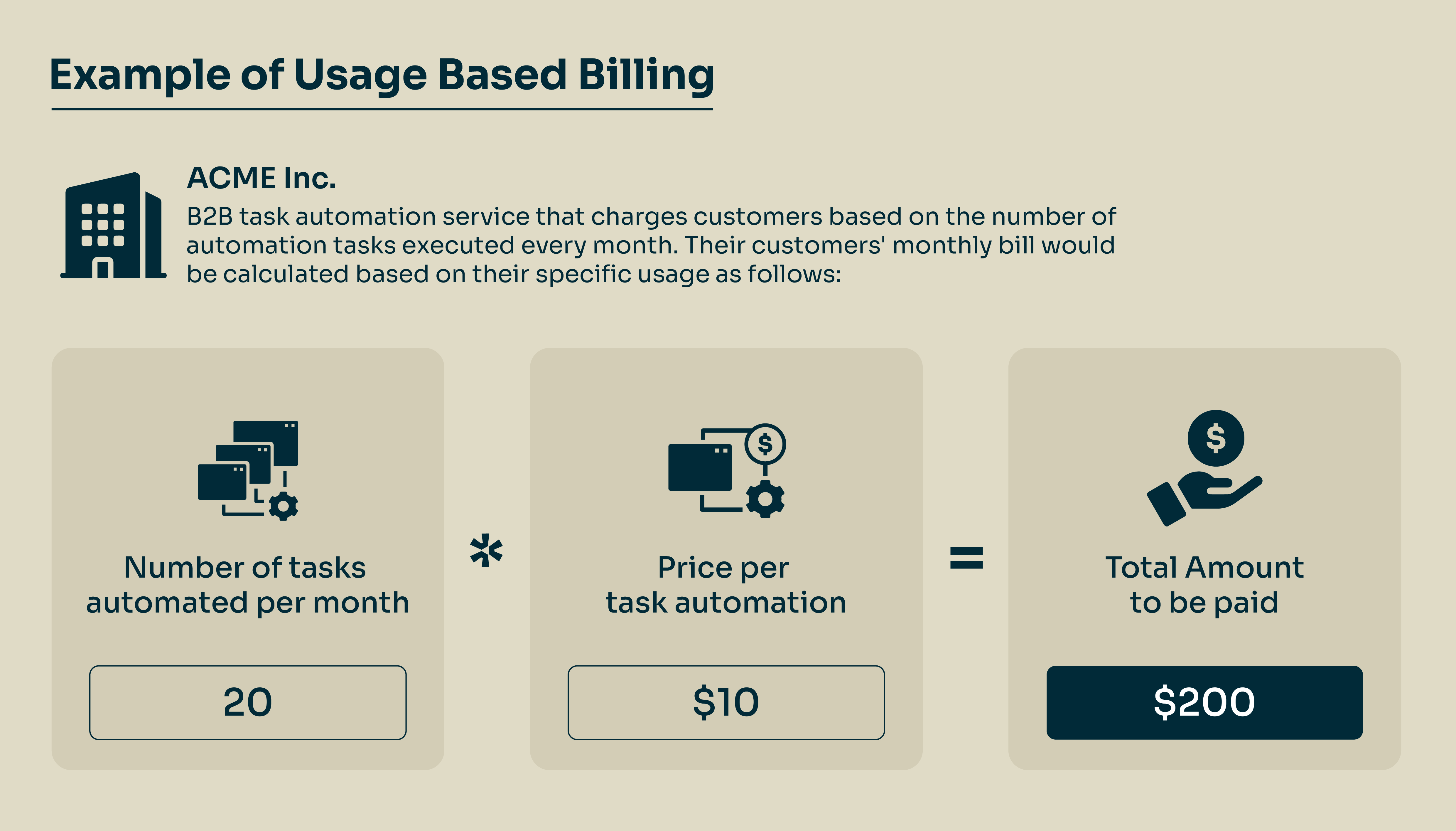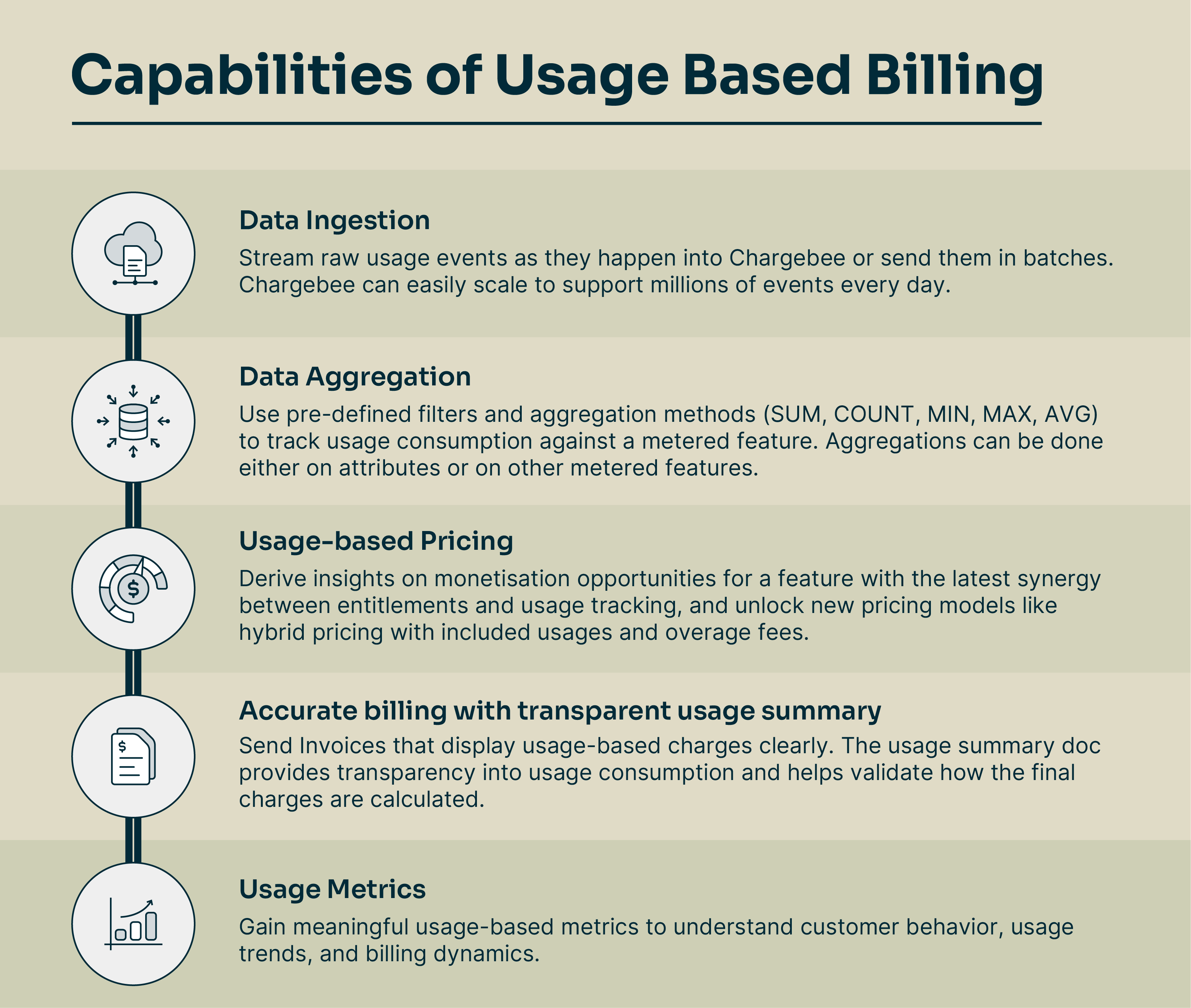Docs
Usage data is critical to your business as it provides clear insights into how customers consume and interact with your products or services. Usage refers to any measurable aspect of a customer's consumption of your product or service.
For example, usage could be:
The usages mentioned here are valuable for monetization, billing, and cost tracking purposes. They do not refer to product analytics, which typically involves clickstream data.
Chargebee Billing allows you to track usage data for your products and services accurately. As the single source of truth for your raw usage data, Chargebee empowers you to track usage based patterns, make important decisions about product packaging, pricing, and manage usage based billing.
Most businesses understand which features of their product or service they want to monetize. However, the full potential often remains untapped without analyzing customer usage patterns. Chargebee unlocks this potential with usage data. If you already know what you want to monetize, Chargebee enables you to move forward with confidence. Additionally, Chargebee's usage events data provides valuable insights, allowing you to identify the features or services that are best suited for monetization.
Following are some key terms around usage tracking and billing that you can familiarize yourselves with:
Usage Events: "Usage Events" are specific actions triggering usage measurements. For Artificial Intelligence tools, events could include input tokens and output tokens. In cloud storage, events could include data uploads, downloads, storage duration, API calls, and data transfers.
The associated usage event data for these actions are sent Chargebee Billing to be tracked. Let's look at some examples:
The usage event data for a Data Upload event includes properties like storage, file type, region, and so on.
{ "event_type": "file_upload",
"timestamp": "2025-01-15T12:34:56Z",
"customer_id": "12345",
"file_size_gb": 0.5,
"file_type": "image/jpeg",
"region": "us-east-1" }
Similarly for API call event, the usage event data includes properties like api method, size of request, and so on.
{ "event_type": "api_request",
"timestamp": "2025-01-15T14:15:32Z",
"customer_id": "12345",
"api_method": "get_file_metadata",
"request_size_kb": 1.4,
"response_size_kb": 10.5 }
Note that Usage Events are NOT the same as Chargebee Billing Events.
Ingestion: This refers to the process of bringing usage events data into Chargebee Billing that triggers usage measurements for billing and data analytics. For example, each data upload into a cloud storage or processing service or each photo edited by an AI tool can be considered a usage event. Bringing this usage event data into Chargebee Billing for usage computation refers to ingestion. The data ingestion for Chargebee Billing can be done via Usages API, bulk import via UI, or manual data addition via UI.
Metered Features: Metered features are specific capabilities or aspects of your product or service that can be tracked based on customer usage along with predefined entitlements. After configuring filtering and aggregation rules, metered features can be associated with:
Metered feature creation is a pre-requisite for aggregation. Aggregation happens based on the mathematical operation defined in the metered feature. Some examples of metered features are API Calls(charging customers based on the number of API requests they make), Data Usage(billing based on the amount of data consumed in GB), No. of users(billing based on the number of users who have singed up).
Aggregation: This refers to the process of combining and summarizing usage data over a specific period or across multiple instances. It involves gathering individual usage measurements from various sources or data ingestions and consolidating them into a cohesive view for billing and analytics purposes. For example, it could be sum of input/output tokens in an AI bot, count of images edited by an AI tool or sum of number of characters translated by an AI tool. It helps you generate accurate invoices by presenting a comprehensive overview of the resources consumed by subscription during a specified time period.
Usage Based Billing: While standard billing typically involves a fixed monthly fee or a predetermined pricing tier, Usage Based Billing(UBB) is a pricing model where customers are billed based on their actual usage of your product or service. In Chargebee Billing you can track usage and bill your customers for the following two types of pricing models:
Following image illustrates an example of PAYG pricing model and how the invoice amount is calculated based on customer usage:

Usage Analytics: Chargebee tracks usage data accurately, aligning it with your business logic and operational needs. It helps you generate meaningful usage based insights, empowering you to understand customer behavior, usage trends, and billing dynamics effortlessly. With usage metrics, you can:
The following image demonstrates the key capabilities of usage tracking and billing feature in Chargebee Billing.

The following usage based billing thresholds apply to your Chargebee Billing site:
Live Site
These thresholds are higher on the Live site compared to the Test site. If your business requires higher limits, please contact us. We can support significantly larger volumes and can discuss pricing based on your needs.